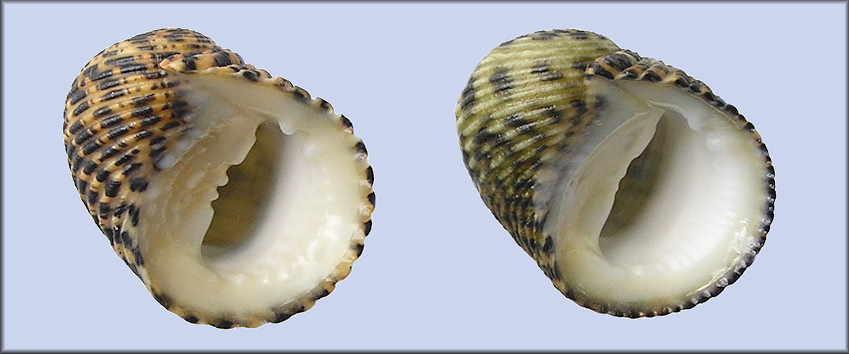|
The image above is a snapshot of a N. fulgurans shell from
Brevard County FL (L; 23.4 mm.) posed with a specimen from the St. Marys
River south jetty on Amelia Island, Nassau County, FL (R; 23.5 mm.).
Taking into account the demonstrated variation in
color pattern, ribbing, etc., one is left with two overriding
differences between these morphs: (1) the greater prominence of the
apertural armature, i.e., denticles/beading on the parietal shelf
and labral folds/denticles, and (2) the more coarsely crenulate outer
aspect of the labrum in the Brevard Co. shell, hereafter the "robust
form."
Except for the elevated spire and more
constricted, less oblique aperture, characters shown above to be
growth-dependent, the Nassau Co. specimen is quite similar to the 17 mm.
figured holotype and paratype of Nerita lindae Petuch, 1988 (pl.
30, figs 4, 5, 11) described from Palm Beach County. Size
notwithstanding, this morphology typifies Nassau Co. shells. Likewise
the Brevard Co. ones are consistently of the robust form; see images on
the previous page.
Are N. fulgurans and N. lindae
different biospecies? At this point, it certainly appears the
morphological differences cannot be explained by ontogenetic factors
alone. If there is a any zoogeographical dissociation between the two,
it is not readily apparent. Our work shows no evidence for a north-south
gradient from Palm Beach to Nassau Co. since the robust form has been
documented from most east Florida counties, e.g. Brevard,
Volusia,
St. Johns, and
Duval
between the type locality of N. lindae and the Nassau Co.
outpost. Considering published and unpublished work by others along with
his own conchological and ecological observations, nerite expert Tom
Eichhorst reports that there are no opercular, radular, or molecular
phylogenetic differences between topotypical N. lindae and
sympatric typological N. fulgurans.
Then what drives these nerite
populations with close to, or entirely, identical constitutions to sort
out into two reasonably distinct morphs? The answer may be the (micro)habitat.
There are hosts of reports dealing with ecological influence on shell
form of a diversity of marine gastropod species, and the nerites are
certainly among them. these include (1) the level of competition for
food in Nerita atramentosa Reeve, 1855
(Underwood, 1976), (2) the predation pressure by crabs on
that species (Chilton and Bull, 1984), and (3) the density of
Neripteron violaceum (Gmelin, 1791) populations (Murty and Rao,
1978). Perhaps the most visibly arresting impact resulted from (4)
experimental work by Minton and Gundersen (2001), which revealed that
the color pattern in the nerite Puperita pupa (Linnaeus, 1767)
was driven by the salinity of the microhabitat rather than genetic
factors as was the accepted theory and basis for the taxon P. tristis
(d'Orbigny, 1842). These workers were able to show abrupt and profound
changes in color pattern (essentially from one "species" to the other)
by simply transplanting living snails between tide pools with different
salt concentrations on the same rocky shoreline. Perhaps the
Nassau County nerite population could be subjected to a comparable
experimental manipulation of environment to test the phenoplasticity of
its shell morphology and thus the phylogenetic basis for Nerita
lindae?
Chilton, M.B. and C.M. Bull, 1984. Influence of
predation by a crab on the distribution of size-groups of three
intertidal gastropods in South Australia. Marine Biology 83:
163-169.
Minton, R.L. and R.W. Gundersen, 2001. Puperita tristis (d'Orbigny,
1842) (Gastropoda: Neritidae) is an ecotype of Puperita pupa
(Linnaeus, 1767). American Malacological Bulletin 16(1/2): 13-20.
Murty, A.S. and M.B. Rao, 1978. Effect of environment on the shell shape
of a tropical estuarine snail Neritina violacea (Gastropoda:
Neritacea). Journal of Molluscan Studies 44: 265-271.
Petuch, E.J., 1988. Neogene History of Tropical American
Mollusks. Biogeography & Evolutionary Patterns of Tropical Western
American Mollusca.The Coastal Education & Research Foundation
(CERF), Charlottesville, VA. [vi] + 1-217 (including 39 plates). 15 Dec.
Underwood, A.J., 1976. Food competition between age classes in the
intertidal neritacean Nerita atramentosa (Gastropoda:
Prosobranchia). Journal of Experimental Marine Biology and Ecology 23:
145-154. |
